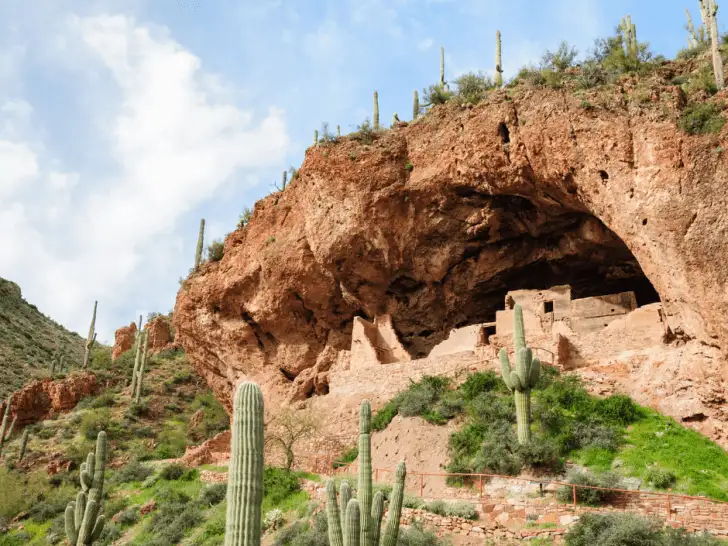Phoenix is an excellent home base for exploring the dozens of national parks in the Southwest. As a matter of fact there are 30 national parks near Phoenix that are all less than six hours away! Some of these parks are managed by the Bureau of Land Management (BLM) so they are wilder and less visited than others, but they all have something special to offer visitors.
I have arranged this guide to the national parks near Phoenix from closest to furthest away. All of these park descriptions also include suggestions on what to see and do once you arrive as well as camping and lodging options.
If you live in the Phoenix area, make it a goal of seeing them all! Our national park units are truly a treasure and a great way of getting our families outside and learning about the history of the land.
30 National Parks Near Phoenix
Agua Fria National Monument
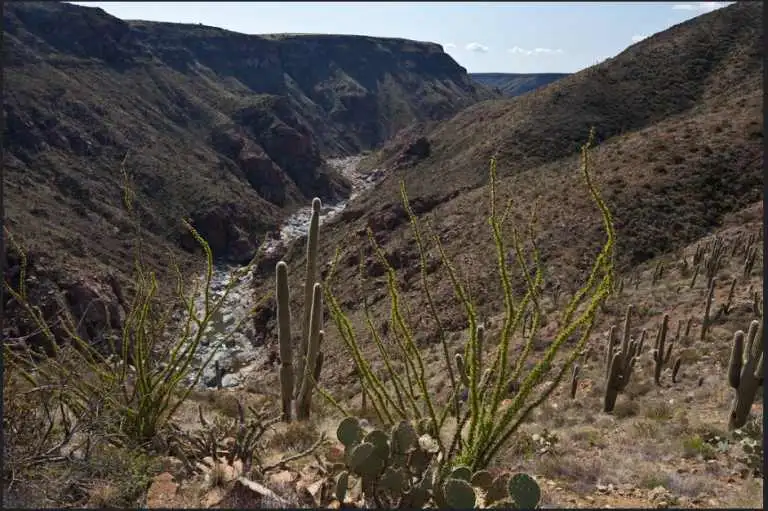
Distance from Phoenix: 40 miles (40 minutes)
Just 40 miles from Phoenix, Agua Fria National Monument covers 72,000 acres of high desert, including two mesas and the rugged canyons surrounding the Agua Fria River. In addition to impressive landscapes, this monument also preserves over 450 Native American archaeological sites.
You can access this monument via Interstate 17 by either taking the Badger Springs Road exit or Bloody Basin Road exit. There are no visitor services so be sure to travel with plenty of water and keep in mind that most of the monument’s dirt roads do require a high-clearance 4WD vehicle.
One of the reasons that this national monument flies under the radar is because it is managed by the Bureau of Land Management (BLM) instead of the National Park Service (NPS). This means it is less developed but it also means that you can explore with less restriction, as long as you respect the Monument. There are no formal trails but there is plenty of opportunity for off-trail exploration.
Popular areas to visit include Badger Springs Wash which leads down into the Agua Fria River Canyon, the Pueblo La Plata archaeological site (4WD required), and the site of the 1891 Schoolhouse which was used by the children of territorial settlers.
Wildlife abounds in Agua Fria NM, and sightings of deer, javelinas, and coyotes are common. Scan the skies for red-tailed hawks, falcons, and mighty golden eagle., an apex predator.
Spend the night: There are no developed campgrounds here but there is dispersed camping allowed within the monument.
Sonoran Desert National Monument
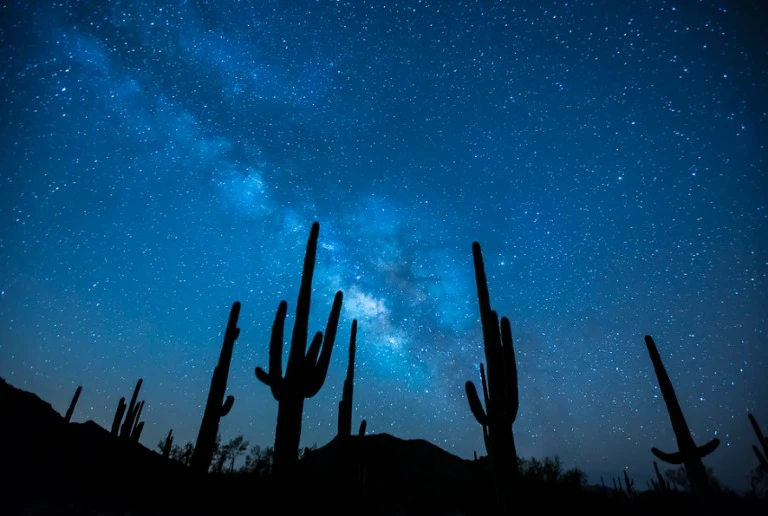
Distance from Phoenix: 60 miles (an hour)
Another national monument that is managed by the BLM and a short distance from Phoenix is the Sonoran Desert National Monument. This is a huge monument, encompassing 500,000 acres, and is home to the Saguaro studded vistas that Arizona is famous for.
Interstate 8 and State Route 238 both cross the monument. You can access the western side of the monument via the town of Gila Bend where there is an information site at the town’s museum. The eastern side is accessed vin Maricopa via State Route 238. The southern end is off of Interstate 8 at Exit 144/Vekol Road.
High clearance, 4WD vehicles are needed to traverse the bulk of the roads in the monument. The Butterfield Overland Stage Route is a historic stagecoach trail that is popular for off-roading. If you don’t have a high clearance vehicle, Vekol Valley Road is a scenic route that most vehicles can handle.
There are no maintained trails but you can hike almost anywhere in the Monument. Popular destinations for hiking include the Table Top Mountain Wilderness, and the North or South Maricopa Mountain Wildernesses.Horses are also allowed in most of the monument.
Remember that there are no services so be sure to bring everything you need with you, including plenty of water.
Spend the night: Two small campgrounds at Margies Cove West and Table Top trailheads offer a restroom. Dispersed camping is allowed throughout the park.
Casa Grande Ruins National Monument
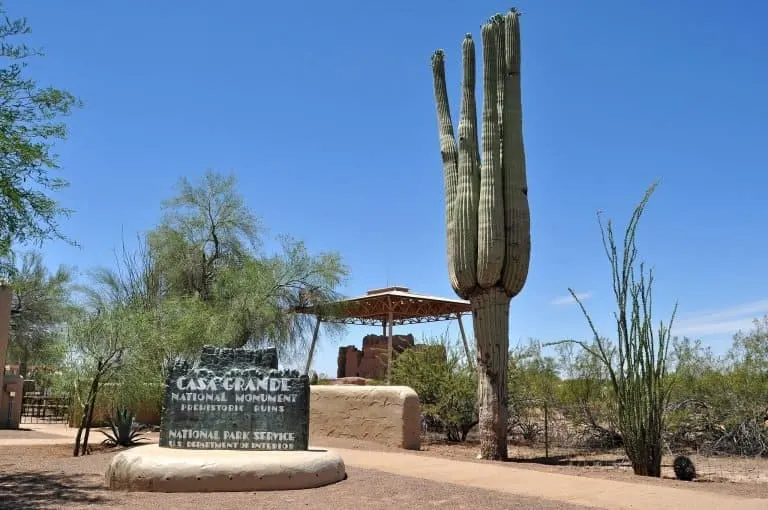
Distance from Phoenix: 54 miles (1 hour, 10 minutes)
If you are making the drive between Phoenix and Tucson, you will want to make time for a pit stop at the Casa Grande Ruins. This is a small monument that can be tackled in an hour. You can even watch the park movie on your phone or computer before your visit which is pretty neat!
This site protects a four-story adobe building that was built buy the Hohokam people way back in 1350. It is one of the best-preserved ancient ruins in the United States.
The best way to experience it is via a guided tour by park rangers which occurs daily at 11am and 1pm. This will help you get a much better understanding of what you are looking at.
Montezuma Castle National Monument
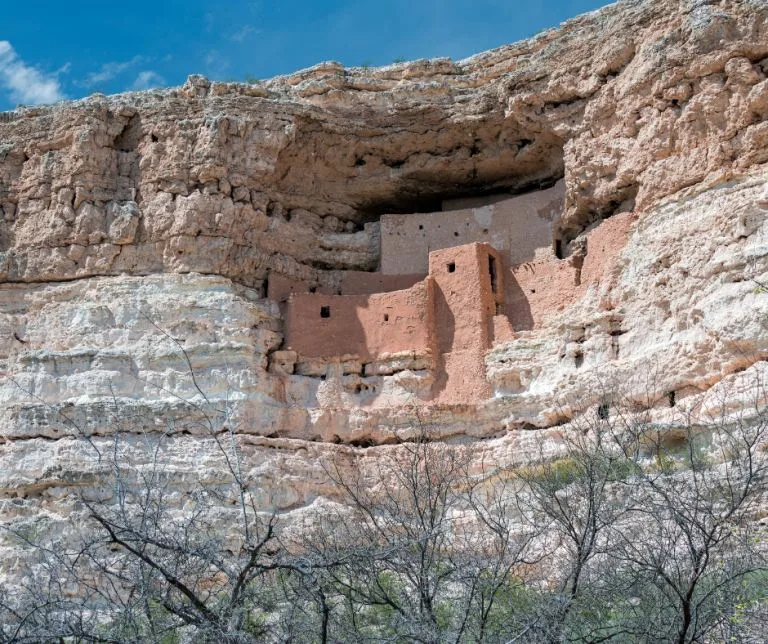
Distance from Phoenix: 93 miles (1 hour, 30 minutes)
Montezuma Castle National Monument is a lovely place to stop for a couple of hours on your way to Sedona, Flagstaff, or the Grand Canyon. It is home to one of the best-preserved cliff dwellings in North America, which was built by the Sinagua people nearly a millennium ago!
While you can’t enter the dwelling, you can view it from a paved trail that winds through a sycamore grove that grows along Beaver Creek. This is a lovely place for a picnic. This is also one of the few parks in Arizona where leashed pets are allowed on the trails.
The visitor center has displays with artifacts from the Singua people and a short film about the history of the cliff dwellings.
Another site associated with this monument is Montezuma Well, located 11 miles north. This natural limestone sinkhole was an important water source for the ancient Singua people. A short loop trail here takes you past views of submerged ruins and prehistoric canals.
Spend the night: The Village of Oak Creek, a suburb of Sedona is home to the gorgeous Hilton Sedona Resort at Bell Rock, a spot I love to visit. Splurge for a room with a view of Bell Rock and sit on your balcony at sunset with a glass of wine and enjoy the colorful show nature puts on.
Tonto National Monument
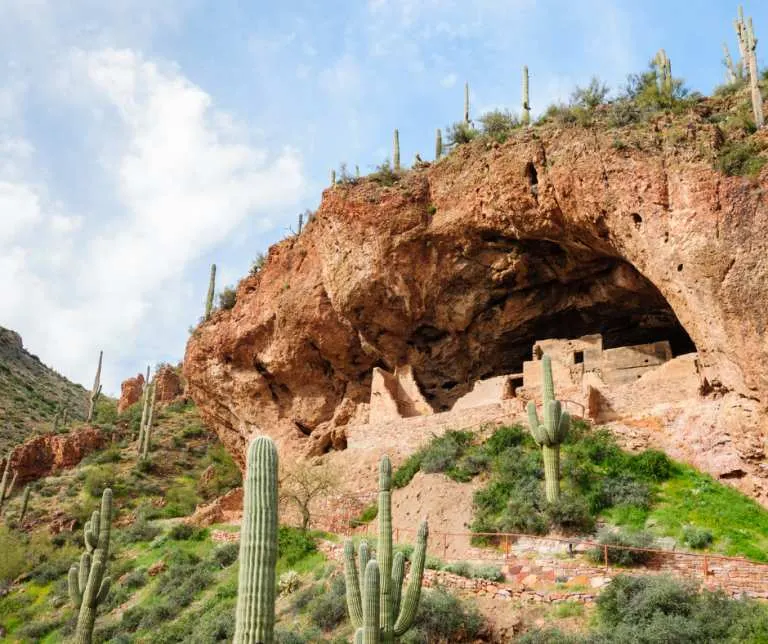
Distance from Phoenix: 110 miles (2 hours)
Another spot that preserves cliff dwellings is Tonto National Monument. These dwellings were built by the Salado people over 700 years ago and are located 2 hours east of Phoenix.
The Lower Cliff Dwelling is open year-round and accessed via a 1-mile round-trip hike that has wonderful views of Roosevelt Lake and the surrounding desert. Visitors are able to enter the dwelling and see the original rooms.
The Upper Cliff Dwelling is only accessible via a guided tour. These tours take place during the cool season (November through April). Reservations are required and can be made beginning October 1st.
The tour is great because the national park guides provide lots of history and information along the way but the 3-mile round trip hike does include 600 feet of elevation gain and some large steps during the 3-4 hour experience so make sure you are prepared for that. Sunscreen, a hat, water, and snacks are all a good idea.
Note: This tour is not recommended for kids under 8.
Spend the night: There is no camping inside of the monument but there are numerous campgrounds within the surrounding Tonto National Forest, including next to Roosevelt Lake. If you aren’t much of a camper, there are cabins available as well.
Saguaro National Park
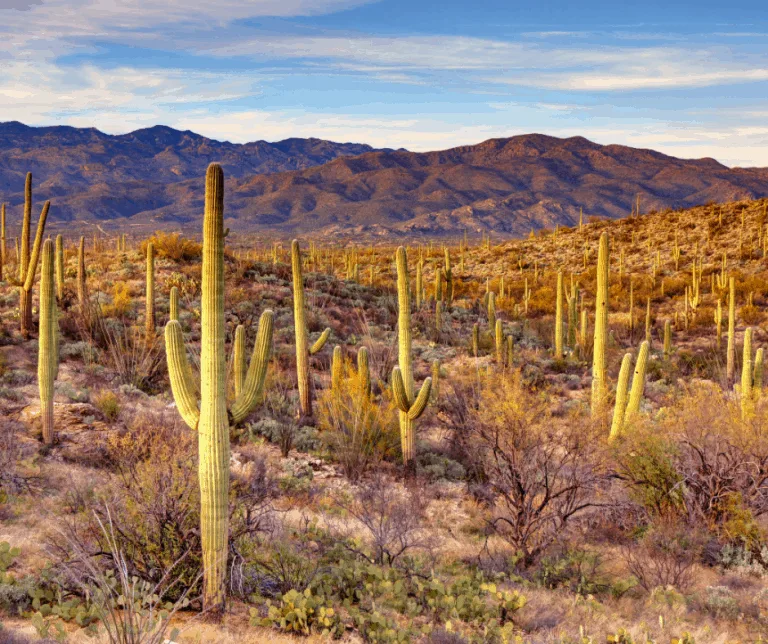
Distance from Phoenix: 135 miles (2 hours, 30 minutes)
The giant saguaro is an icon of the Arizona landscape. Seeing them stand like statues amidst the rocks and hills of Saguaro National Park is absolutely beautiful, especially during wildflower season.
There are two districts of the park-Tucson Mountain and Rincon Mountain- separated by the city of Tucson. Both are great for day visits with visitor centers, hiking trails, and picnic areas. Take a first aid kit (including tweezers for cactus pokes) and lots of water on any hike, even in winter, because of the low humidity.
If you are looking for easy hikes, The Freeman Homestead Trail on the east side is a one mile loop with interpretive signs. The Signal Hill Trail on the west side is a ½-mile climb to dozens of ancient petroglyphs.
Desert blooms come alive with winter and spring rains. Most of the park is sweltering during the summer, but you can still explore the higher elevation backcountry in the Rincon Mountains during the summer.
Spend the night: Stay at White Stallion Ranch, an all-inclusive dude ranch, and take the full day ride into Saguaro National Park. There are also several great Tucson resorts nearby.
Sunset Crater Volcano National Monument
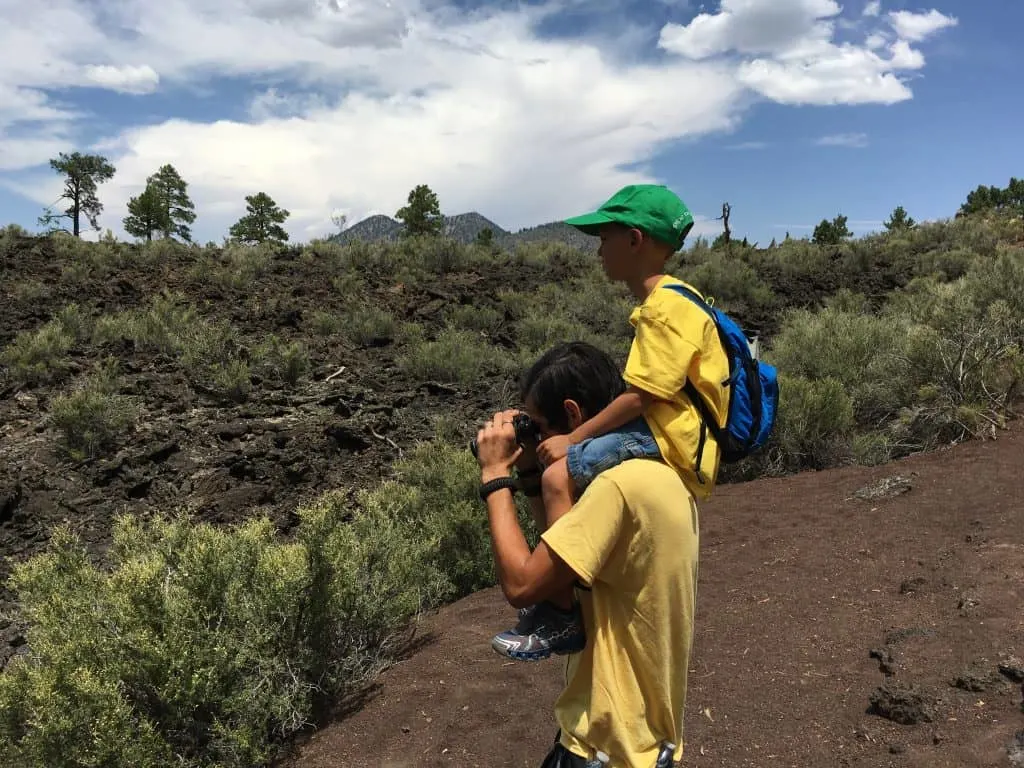
Distance from Phoenix: 164 miles, (2 hours, 40 minutes)
Just north of Flagstaff is Sunset Crater National Monument which reserves the remains of a volcanic eruption that occurred about 1,000 years ago. There are lava flows, cinder cones, lava tubes, and hiking trails to explore in this park.
After you stop by the Visitor Center to learn about the eruption, walk the Lava Flow Trail to take in nice views of the crater and the lava formations. You can also take the Lenox Crater Trail which is a 1.6 mile loop in a pine forest with views of the Bonito Lava Flow and the surrounding mountain peaks.
Spend the night: Bonito Campground is right across from the park visitor center and operated by the US Forest Service. If you are looking for four-walled lodging there is plenty to choose from in Flagstaff.
Tumacacori National Historical Park
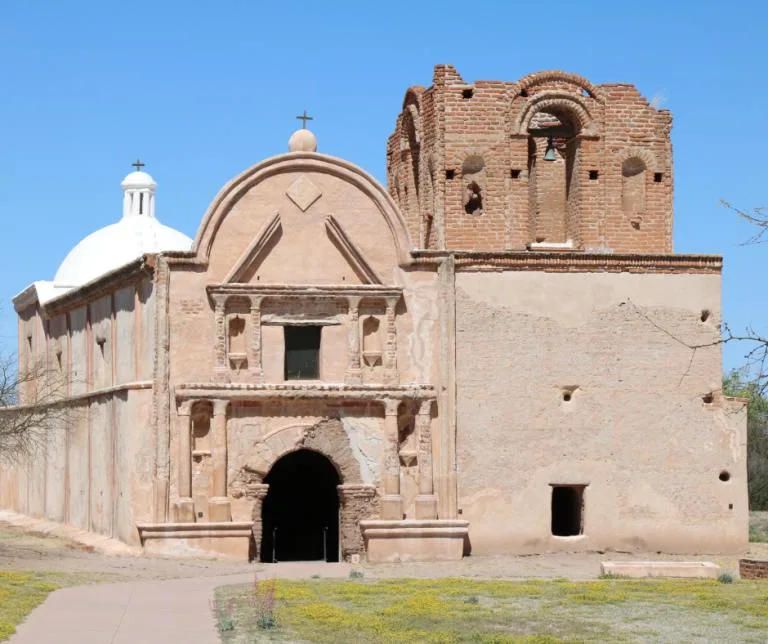
Distance from Phoenix: 160 miles (2 hours, 40 minutes)
The Tumacacori National Historical Park protects Mission San José de Tumacácori, a Spanish mission founded by Father Eusebio Francisco Kino in January 1691 It was the first mission built in what is now Arizona.
The park is open daily (except Christmas and Thanksgiving) from 9am – 5pm. You can explore the park museum and mission site on your own or take a guided tour. Fall through spring, there are often artisans onsite demonstrating traditional skills such as O’odham basket weaving, tortilla making, and leather working.
If the weather is nice, make time to take a 1.5-mile hike along the Santa Cruz River on a portion of the Juan Bautista de Anza National Historic Trail.
Spend the night: This park is 45 minutes south of Tucson. We suggest heading there for lodging.
Tuzigoot National Monument
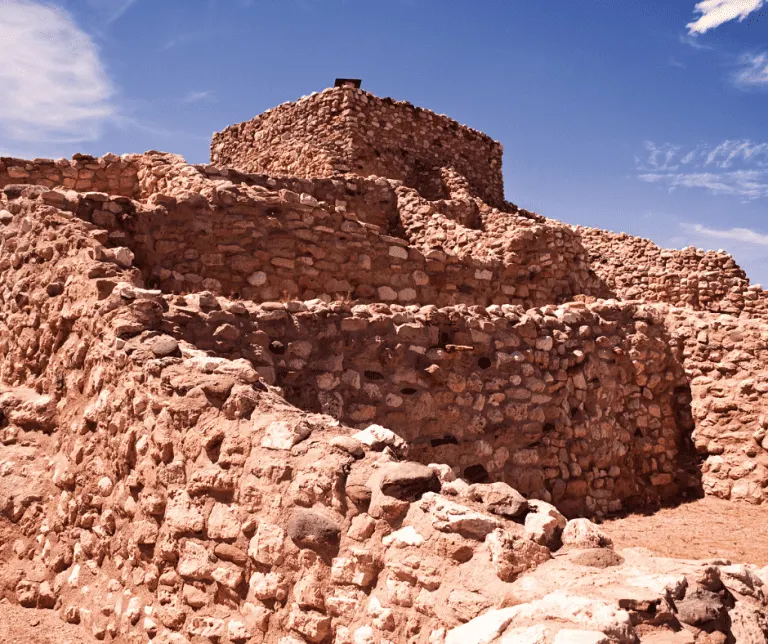
Distance from Phoenix: 107 miles (2 hours)
Tuzigoot is located close to Sedona and Jerome, and is a nice pit stop when heading to either of those destinations. This monument protects the ruins of the 1,000-year-old Tuzigoot Pueblo which once had 110 rooms!
The park museum has displays about the Sinagua people including artifacts such as pottery and jewelry. After you visit the museum, head to the self-guided trail which loops around the ruins and has informational panels to read along the way.
Trekaroo tip: Keep your receipt for Tuzigoot and use it to gain entrance to Montezuma Castle National Monument for free within 7 days.
Spend the night: Stay in nearby Sedona which has several great resorts such as The Enchantment Resort and El Portal Sedona.
If you camp, head up into Oak Creek Canyon where the red rocks meet the Ponderosa pines. Cave Springs Campground has 84 campsites and Slide Rock State Park is just down the road.
Walnut Canyon National Monument
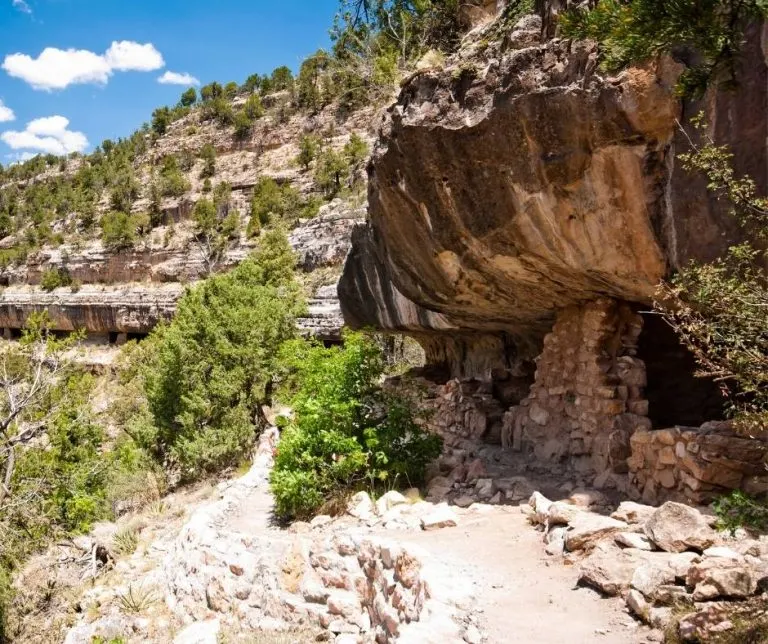
Distance from Phoenix: 150 miles (two hours, 15 minutes)
Another national monument just outside of Flagstaff is Walnut Canyon NM. This site protects about 25 cliff dwellings built by the Singua people over 800 years ago. The Walnut Canyon NM visitor center is a good place to start your visit. Watch the park film and take a gander at the museum before heading to the dwellings.
The Island Trail is the best way to see these dwellings which cling to the pine and juniper studded cliffside of Walnut Canyon. This 1-mile loop takes about an hour to explore and entry does close at 4pm daily. Keep in mind that trails can be closed due to snowfall in the winter.
The Rim Trail is another short hike (0.7 miles) within the park. It allows you to enjoy a nice walk along the canyon rim and view the cliff dwellings from above. During the summer there is a demonstration garden showcasing the traditional crops of the Sinagua people.
Spend the night: Flagstaff has several different lodging options for families including the Little America Hotel which has nature trails, a disc golf course, a pool, and playground.
There are several campgrounds in the area including the Lakeview Campground near Upper Lake Mary.
Wupatki National Monument
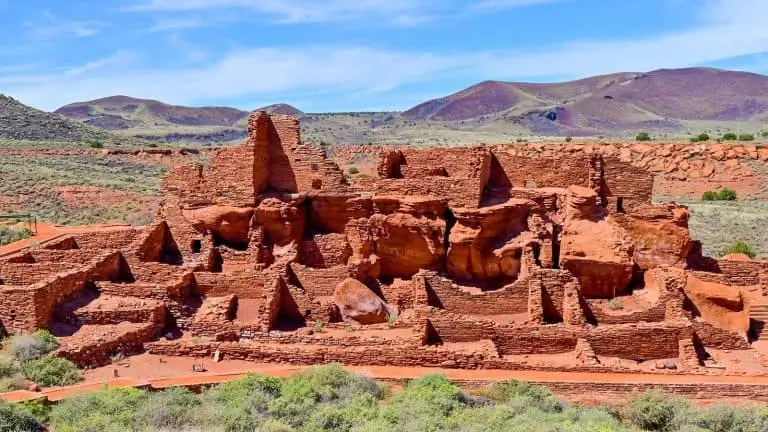
Distance from Phoenix: 174 miles, (2 hours, 40 minutes)
Wupatki National Monument is north of Flagstaff and easy enough to add to a trip to the mountains or the Grand Canyon. Built in the 1100’s, the Wupatki Pueblo once had 104 rooms, as well as rooms for ceremonial events.
You can see the whole pueblo from an overlook behind the visitor center or better yet, take the 1/2-mile round trip trail to the site and see it up close. Beyond this pueblo, you can also visit the Wukoki Pueblo, Lomaki and Box Canyon Pueblos, or the Citadel and Nalakihu Pueblos via short trails within the park.
There are a couple off-trail, ranger-led hikes which take you to even more Ancestral Pueblo structures and petroglyphs while learning from an expert along the way. These take place on Saturdays and need to be reserved in advance.
Spend the night: See our listing for Walnut Canyon (above) for suggestions.
Organ Pipe Cactus National Monument
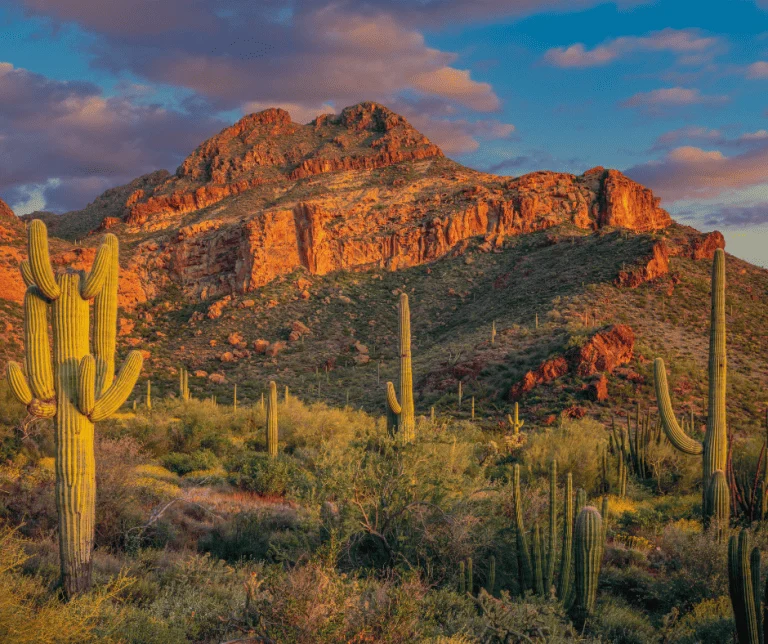
Distance from Phoenix: 145 miles, (2 hours, 45 minutes)
Hugging the southern border with Mexico, Organ Pipe Cactus National Monument is a beautiful desert park known for its scenic drives and hikes. It has been recognized as an International Biosphere Reserve for its pristine desert ecosystem.
Most of the roads here are dirt roads that require a high clearance, 4WD vehicle, however there are still some good options for us 2WD folks. Ajo Mountain Drive is a 21-mile, one-way gravel road that is suitable for most vehicles. It has plenty of great views and different types of cacti including the organ pipe, saguaro, cholla, and barrel. Alamo Canyon and Pinkley Peak roads are two other options.
Spend the night: Twin Peaks Campground has over 200 sites, with options for tents and RVs but no hookups. There are bathrooms and water available here.
Coronado National Memorial
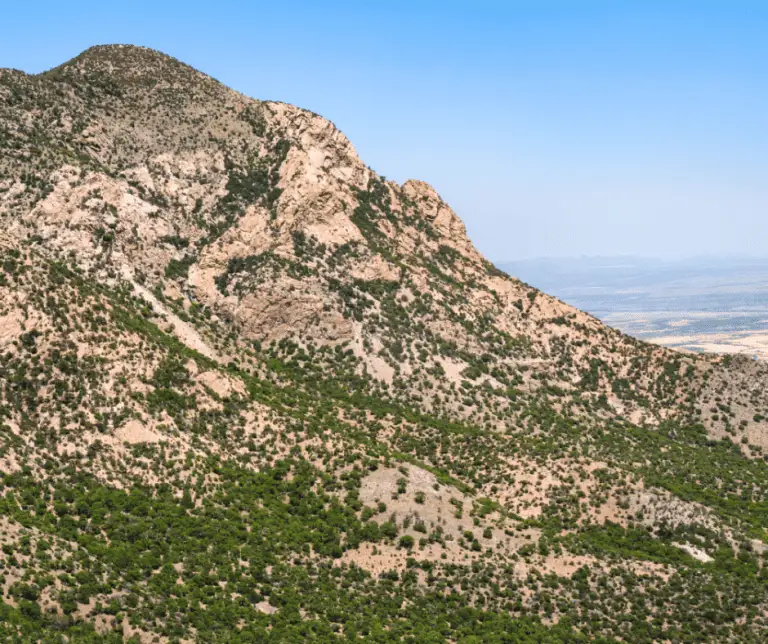
Distance from Phoenix: 206 miles (3 hours, 30 minutes)
Coronado National Memorial is another park in Southern Arizona near the border with Mexico. It commemorates the first major European expedition into the American Southwest by Francisco Vázquez de Coronado in 1540.
Start at the visitor center and watch the short film about Coronado’s expedition. Then check out the exhibits about both the Spanish conquistadors and the Native cultures that were inhabiting the region at the time.
Then take the drive up to the Montezuma Pass Overlook which has panoramic views of the San Pedro River Valley and into Mexico. This is also where you will find the trailhead to Coronado Peak which is accessed via an easy, 0.8-mile round trip hike.
Bring flashlights or headlamps so you can explore Coronado Cave, an undeveloped limestone cave that is really fun to explore. As you drive through this desert park keep your eyes out for wildlife such as mule deer, coatimundi, and all sorts of birds on migration.
Spend the night: There are no campgrounds inside this park but you can find campgrounds in the nearby Coronado National Forest. Those looking for four-walled lodging should head to funky Bisbee, a historic mining town with an artsy flair.
Grand Canyon National Park
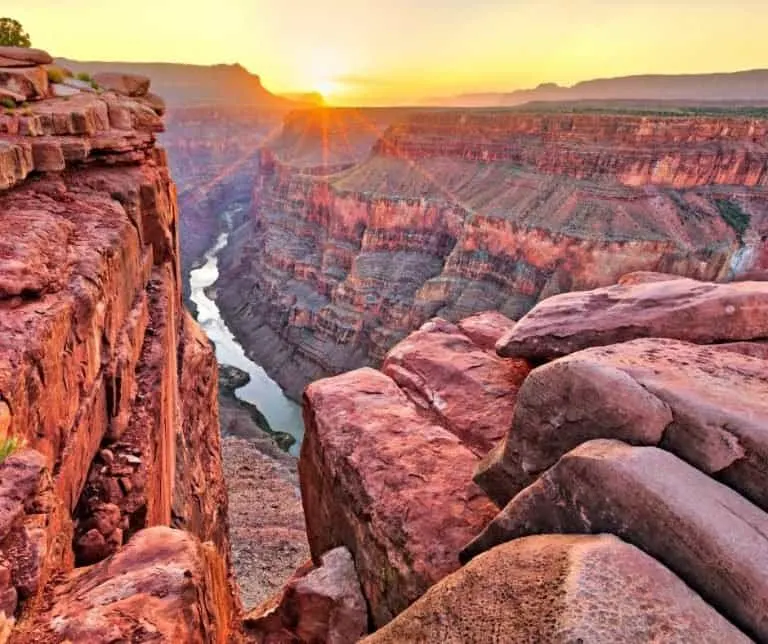
Distance from Phoenix: 228 miles (3 hours, 30 minutes) for the South Rim, 351 miles (5 hours, 40 minutes) for the North Rim.
The Grand Canyon is one of the country’s most visited landmarks, with nearly 5 million visitors per year. The South Rim is by far the most visited, thanks to its close proximity to Phoenix and Las Vegas and it being open all year.
Only 10% of visitors head to the North Rim. It is much more remote and at a higher elevation (8,000 feet), so it receives more snow and is only really open from May 15 through October 15 each year. We have a great guide to visiting the North Rim of the Grand Canyon if you decide to head up that way.
If you opt for the South Rim , you will find much more in the way of both services and crowds, especially during the summer and school holidays. Arrive early in the day if you want to secure a parking space.
The Rim Trail follows the rim of the Grand Canyon for 13 miles and can be picked up at various spots along the park’s shuttle route. Spots like Pima Point and Hopi Point are popular for sunrise and sunset.
Hiking below the rim is very strenuous with dangerous cliffs. Don’t overestimate your or your kid’s ability for hiking and plan extra time for your return trip up the canyon. It usually takes twice as long to return uphill as it does to go down. Keep in mind that temperatures increase as you go down in elevation and the humidity is low so your body can become dehydrated quickly.
We have a full guide to visiting the Grand Canyon South Rim which includes activities, lodging, and dining.
Spend the night: If you can stay at one of the park’s lodges, you will be rewarded with portions of the day when the day trippers are gone and you feel like you have the views all to yourself.
On the South Rim I recommend staying in the Bright Angel Lodge area which is the hub of activity. On the North Rim, you will want to stay in the lodging surrounding the Grand Canyon Lodge.
On the South Rim, there are three developed campgrounds (Mather, Trailer Village, and Desert View) and reservations well in advance are highly recommended. Desert View is only open April 12 through October 12.
On the North Rim, the North Rim Campground is seasonal (May 15 – October 15) and reservations are highly recommended well in advance.
Petrified Forest National Park
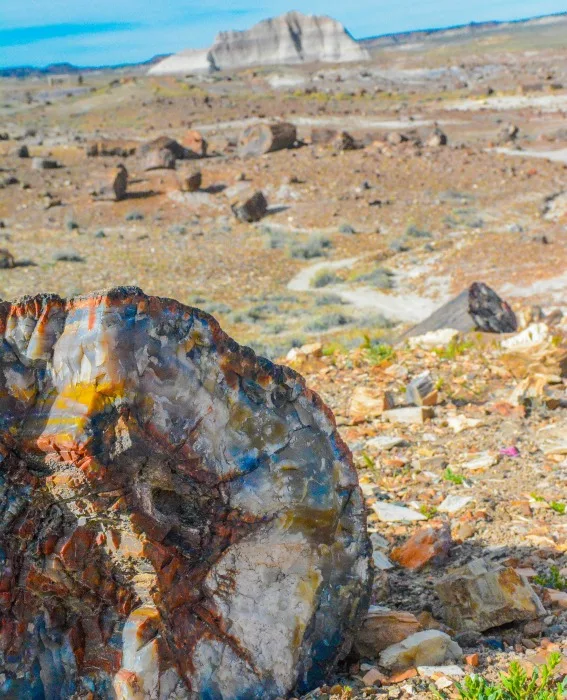
Distance from Phoenix: 212 miles (3 hours, 30 minutes)
Petrified Forest National Park is known for its hues of color found in the petrified wood and sedimentary hillsides in this park northeast of Phoenix.
Over 200 million years, logs have been replaced by minerals and transformed into sparkling rainbow rocks. The striated canyons of the Painted Desert and Blue Mesa testify of the beauty of the desert. Drive the 28-mile scenic road and take in the colorful views.
There are several short trails that show off the park’s highlights. Walking on the short, 0.75-mile Crystal Forest Trail, expect to see lizards, birds and small rabbits among the colorful petrified rock logs. On the one-mile Blue Mesa Trail loop you will descend into a canyon highlighted by deep shades of blue.
Spend the night: Stay in La Quinta Inn in Holbrook, Arizona which is close to the national park and has an indoor pool .
There is a KOA in Holbrook which has laundry, a dog park, a playground, sports courts and seasonal chuckwagon dinners. There is no camping inside of the park.
Joshua Tree National Park
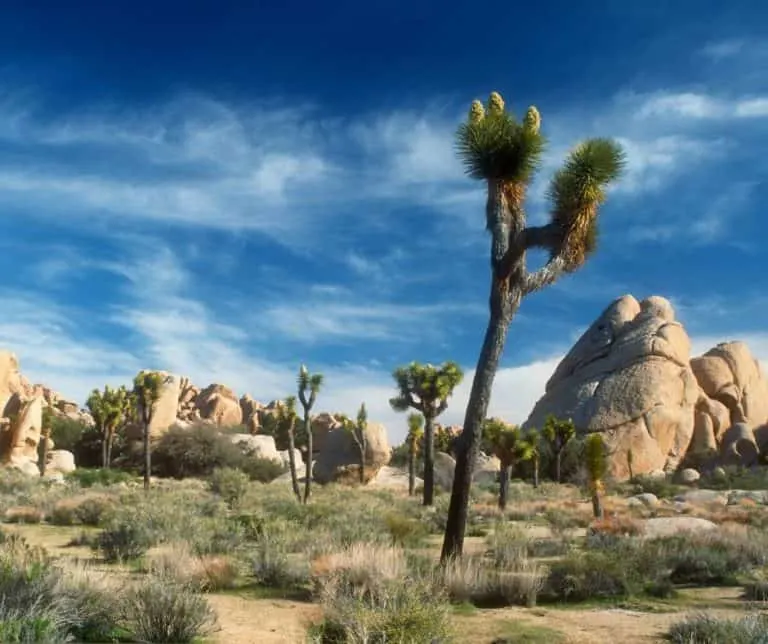
Distance from Phoenix: 222 miles (3 hours, 30 minutes)
Believe it or not, Joshua Tree National Park in Southern California is basically the same distance from Phoenix as the Grand Canyon! In this national park, the high desert meets the low desert and towering boulders and Seussian trees are the stars of the show.
Climbing around on the massive boulders that look like they have been left in piles by a race of extraterrestrial giants is my family’s favorite activity inside the park You will see professional climbers scaling the boulders with their equipment, but amateurs will have just as much fun climbing around in spots like Hidden Valley and Jumbo Rocks.
The best time to visit this park is in the spring after a wildflower bloom but any season outside of summer is a good time to head to Joshua Tree.
Hike Maze Loop Trail, the Barker Dam Trail (keep your eyes out for bighorn sheep), and if you are looking for a big challenge, the steep Ryan Mountain trail which gains 1,000 feet in just 1.5 miles. We have a full guide to visiting Joshua Tree with several more activities and tips to make the most out of your stay.
Spend the night: There is no lodging inside the national park except for camping. Try the Joshua Tree Inn or rent a funky VRBO in the artsy little hamlet of Joshua Tree.
If you do camp, I love the Jumbo Rocks Campground inside the park which has incredible scenery and is reservable.
Here are 15 of the best national parks in California.
Chiricahua National Monument
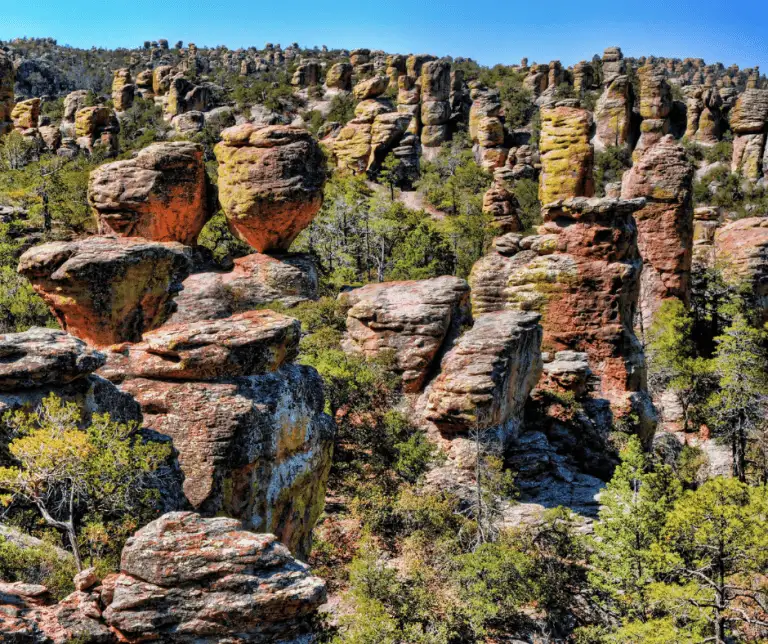
Distance from Phoenix: 230 miles (3 hours, 50 minutes)
Chiricahua National Monument is also known as the “Wonderland of Rocks” because of its remarkable landscape filled with towering rock pinnacles that were created by volcanic eruptions 27 million years ago.
It has a unique ecosystem that combines desert, grasslands, and forested mountains — called a “sky island”. As you can imagine, the wildlife (deer, birds, and coatimundis are most common) and scenery are abundant. You can get a good overview of the park by taking the 8-mile scenic drive from the visitor center to the top of the mountains at Massai Point.
There are several great hikes to enjoy while walking among the Pinnacles. The 3.3-mile Echo Canyon Loop is the most popular because it has plenty of Stone spires, slot-like passages, and grottoes to explore. Some of the most famous balanced rocks can be seen on the Heart of the Rocks Loop.
Spend the night: There are 25 first-come, first-served sites at Bonita Canyon Campground which are best for tents and small RVs. Motels can be found in nearby Wilcox including Holiday Inn, Days Inn, and a highly-rated Best Western.
Fort Bowie National Historic Site
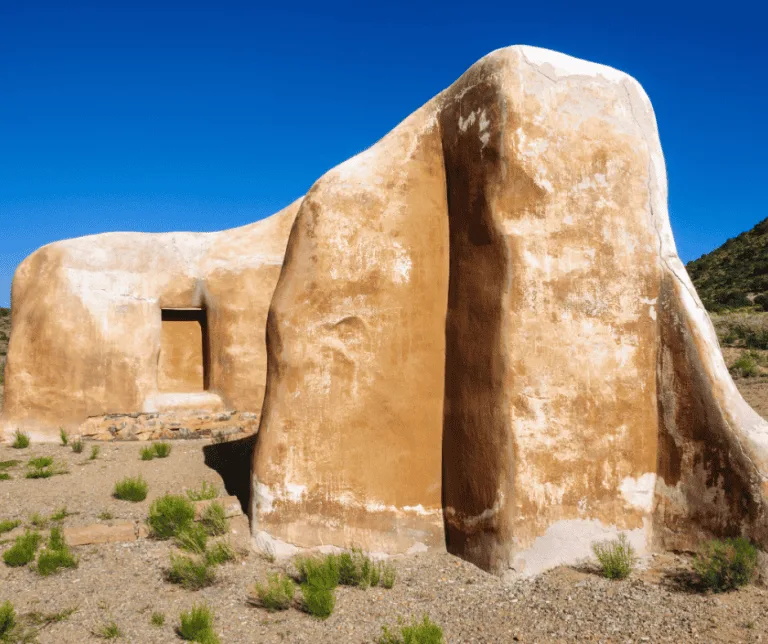
Distance from Phoenix: 234 miles (4 hours)
A visit to Fort Bowie National Historic Site is a step back in time to the days of the American frontier and the complex history of the Apache Wars. The site preserves the ruins of Fort Bowie, an important U.S. Army outpost from 1862 to 1894 which played a key role in the long conflict between the US Military and the Apache people, including Geronimo.
This site is located 13 miles south of Wilcox and takes a bit of effort to reach. You will first drive down a well-maintained gravel access road before hiking 1.5 miles to reach the ruins. The hike is easy and there are stops along the way including Apache Spring, a cemetery, and a portion of the Butterfield Overland Mail Route. The trail is exposed so we suggest walking it early in the day.
When you arrive at the Fort ruins you will also find a visitor center and museum that is worth exploring. Take time to walk the grounds where you will see where the barracks, officers’ quarters, guardhouse, and hospital once stood. Keep in mind that the visitor center is only open from 8 – 4 most days. We suggest combining a visit to this site with Chiricahua National Monument (above).
Spend the night: See the suggestions for Chiricahua National Monument.
Lake Mead National Recreation Area
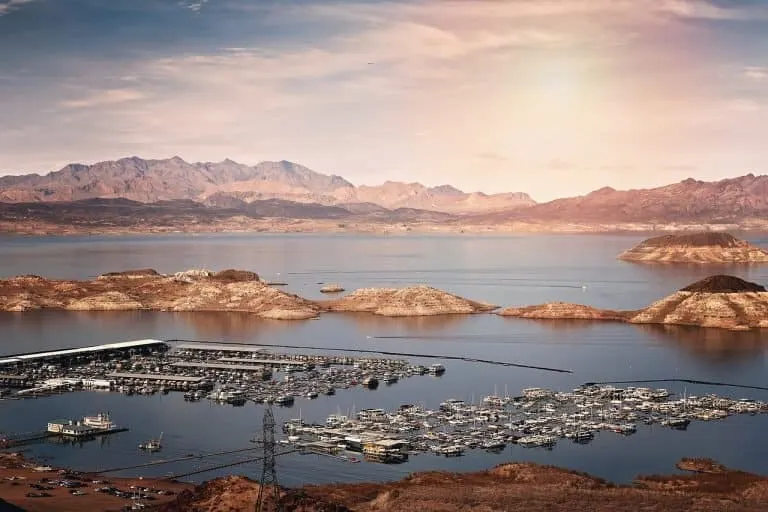
Distance from Phoenix: 234 miles, (4 hours)
Lake Mead is the largest reservoir in the country and an extremely popular destination for boating, hiking, water sports, and houseboating. The lake was created by the construction of Hoover Dam on the Colorado River, even though water levels have declined there are still over 300 square miles of water surface to explore and enjoy.
On the western edge of Lake Mead you can take a tour of Hoover Dam, and walk across the top of it for dizzying views of the Colorado River below.
During the winter when the weather is cooler, hiking is a great activity to enjoy. The Historic Railroad Trail (3.7 miles each way )is a cool trail through old railway tunnels leading to Hoover Dam.
One thing you might not know is that a B-29 Superfortress plane crashed into Lake Mead in 1948 and it has been at the bottom of the lake ever since. Dive companies do offer guided scuba diving trips to wreckage sites.
Lake Mojave is also part of the Lake Mead National Recreation Area. It is located south of the Hoover Dam and has great boating, water sports, and swimming opportunities as well.
Spend the night: I love a good houseboat trip so I highly suggest you rent a houseboat at least once while your kids are young. Callville Bay rents a variety of houseboats. If you prefer to camp on land, Lake Mead RV Village is a popular spot on Boulder Beach and offers full hookups. If you are just taking a day trip to the lake, Las Vegas is only 30 minutes away.
Glen Canyon National Recreation Area and Rainbow Bridge National Monument
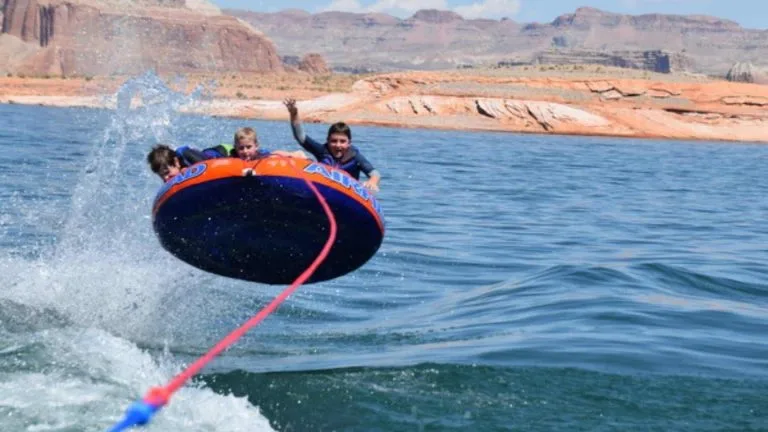
Distance from Phoenix: 277 miles (4 hours, 15 minutes)
Glen Canyon National Recreation Area is home to Lake Powell, a desert paradise resulting from the Glen Canyon Dam holding back the waters of the mighty Colorado River. I like to describe it as the Grand Canyon if it was flooded with water. It ranks up there as one of my favorite places in the entire country.
When full, this lake that straddles the Utah/Arizona border and stretches for over 175 miles, with dozens of coves and inlets to explore. The typically hot, dry summer weather makes it ideal for houseboats and water sports. Three million people visit Lake Powell each year but the lake is so vast, you will often feel like you have the entire lake to yourself.
Read our article on houseboating in Lake Powell.
Boat tours of Lake Powell are operated out of Wahweap Marina that go to various locations within the lake. There is even a dinner cruise which allows you to enjoy the colors of the pastel sandstone bluffs as the sun goes down.
Float trips of the Colorado River below the Glen Canyon Dam to Lees Ferry are also available. The float trip allows you to cruise around the famed Horseshoe Bend with sandstone walls towering around you. Children as young as four can enjoy these half-day trips.
If you are already planning a visit to Lake Powell, then you will want to make time to visit Rainbow Bridge National Monument which is located next to Lake Powell. It is the world’s largest natural bridge that towers 42 feet high and 234 feet wide. It is an impressive sight for sure!
Unfortunately, due to low lake levels, accessing the bridge is much more difficult than it was in years past. The water level is lower than where the boat docks and restroom were placed, so the only way to reach it now is by taking a small boat that can be beached. Then you must hike 1.5 miles to the bridge. Portions of the trail are very mucky because until recently, they were under water.
Read about current conditions on the National Park Service website before heading out.
Spend the night: Lake Powell Resort is located right at Wahweap Marina, where all your boat tours will depart. You can also rent power boats from this location and explore on your own.
There is dispersed camping available all over Lake Powell which is accessible if you have a houseboat or powerboat. I also have fond memories of RV camping right on the shore at Lone Rock Beach Primitive Camping Area as a kid. This is located right next to the Off Road Vehicle area so if you own those, bring them!
Navajo National Monument
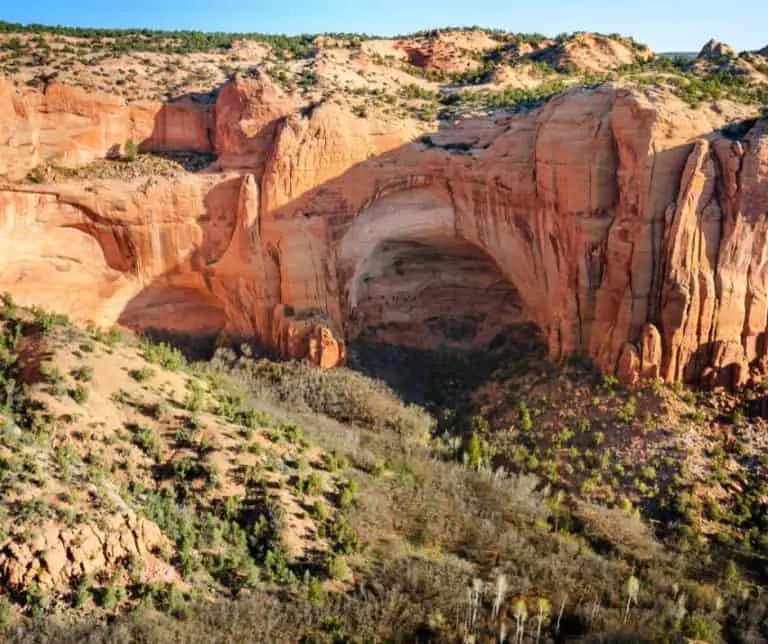
Distance from Phoenix: 282 miles (4 hours, 20 minutes)
Navajo National Monument is located about 10 miles off Hwy 160, the main highway crossing the Navajo Nation in Arizona. It protects three Ancestral Pueblo cliff dwellings in the Tsegi Canyon area.
The cliff dwellings can only be toured with a ranger on Saturdays and Sundays from Memorial Day through Labor Day at 7am. The most popular is the Betatakin dwelling which is reached via a fairly strenuous, five-mile round-trip hike. These dwellings were last occupied in 1300 AD.
Those with less time can visit the park museum and watch the park video before heading outside and looking at the dinosaur tracks imprinted in sandstone that are on display. Then stretch your legs by taking the 1.3-mile (round trip) Sandal Trail to an overlook with a nice view of the Betatakin dwelling framed by a sandstone arch.
Spend the night: The town of Kayenta on the Navajo Nation is the closest option for lodging. There is also a campground inside the park.
Camping is FREE and available on a first come, first served basis. Sunset View Campground is open all year and accommodates RVs up to 28 feet as well as tents.
Hubbell Trading Post National Historic Site
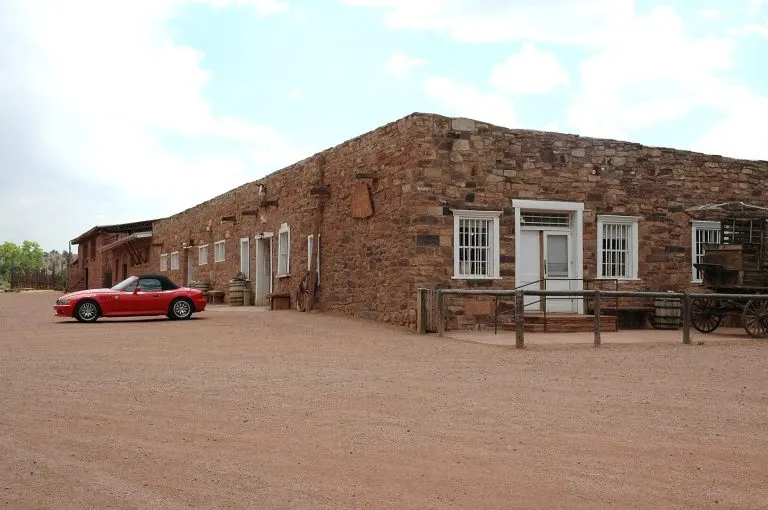
Distance from Phoenix: 272 miles (4 hours, 30 minutes)
Located on Navajo tribal land, the Hubbell Trading Post is a place where you can shop for Navajo rugs, Native American jewelry, baskets, and pottery, just as it has been done for over 140 years. The site is meant to serve as a site preserving the cultural exchange between the Navajo people and the settlers in the Southwest in the late 1800s.
In addition to visiting the trading post, you can also take a ranger-guided tour of the original Hubbell family home. It still is decorated with authentic furnishings and artwork that were collected by John Lorenzo Hubbell. You will also learn about his role as a trader who served as a bridge between the worlds of the settlers and Navajo people.
There is also a barn area with Churro sheep and other farm animals. Be sure to also check out the Navajo weaving displays; often there is someone putting on a live weaving demonstration.
Spend the night: This National Historic Site is about an hour from Petrified Forest National Park and would ideally be visited as a day trip from that area.
Mojave National Preserve
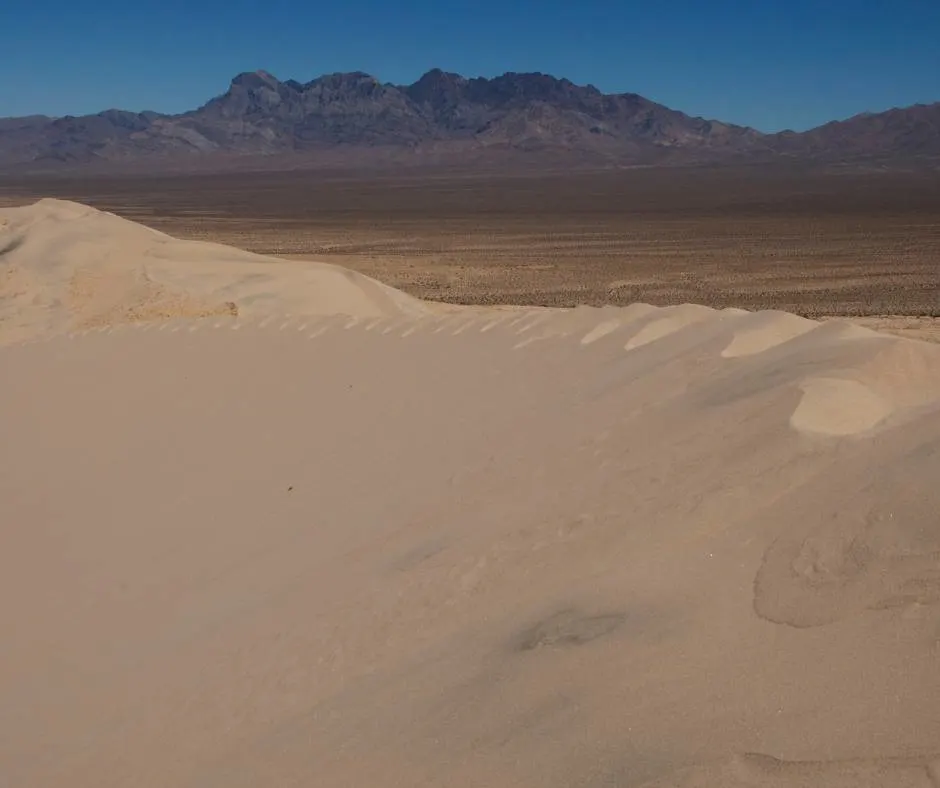
Distance from Phoenix: 251 miles, (4 hours, 30 minutes)
If you have ever made the drive from Los Angeles to Las Vegas on Interstate 15 then you have driven along the northern edge of Mojave National Preserve. This vast and wild preserve protects a pristine high desert ecosystem.
Trekaroo tip: Many of the roads inside the Preserve were damaged by summer storms a couple years back so check the park website for road updates before your visit.
It is home to Kelso Dunes, some of the largest sand dunes in the country which rise 600 feet above the desert floor. These dunes are known to “sing”, making a deep sound that happens when your group heads to the top of the dunes and pushes as much sand off the top as possible.
Another one of the big attractions at Mojave National Preserve is the lava tube. It was created by molten lava 27,000 years ago. There is a beam of light that shines into the lava tube at certain times of day (usually early afternoon in the summer) making it a beautiful spot for photos.
If you are looking for a fun hike, try the 1.5-mile Hole-in-the-Wall Rings Trail. This trail takes you through Banshee Canyon and its swiss-cheese like holes in towering rock formations. The real fun is when you use rock-mounted ring bolts to climb into the rocky amphitheater at the bottom of Banshee Canyon.
Spend the night: There are a couple campgrounds within the park (Mid Hill and Hole-in-the-Wall) that are first come, first served. If you are looking for lodging, your best bet is to use Las Vegas or Primm as your home base for exploration.
Vermilion Cliffs National Monument
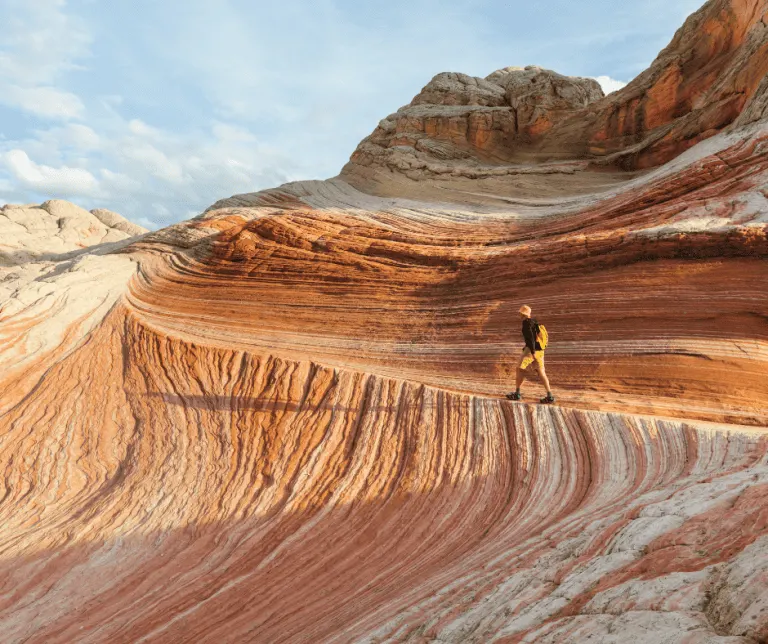
Distance from Phoenix: 294 miles (4 hours, 30 minutes)
Vermillion Cliffs National Monument is home to the famous Wave formation, a destination so popular that a lottery system has been in place to limit visitation and protect it.
But there is so much more to Vermillion Cliffs than that! The towering cliffs near the Arizona/Utah border are visible from many miles away and the entire monument covers a whopping 280,000 acres. It is home to narrow slot canyons, unusual rock formations, and the critically endangered California condor.
A high clearance vehicle is required to access much of the monument but there are tour companies in Kanaba and Page that will take you to incredibly scenic spots in locations such as White Pocket and South Coyote Buttes, an excellent alternative to the Wave.
Spend the night: Kanab is a great place to call home base while exploring the area. The Canyons Lodge has cute, Southwestern-styled rooms and is surrounded by red rock scenery. Glampers will surely want to stay at Under Canvas Lake Powell which even has kids tents available for inside of the larger glamping tents!
Canyon de Chelly National Monument
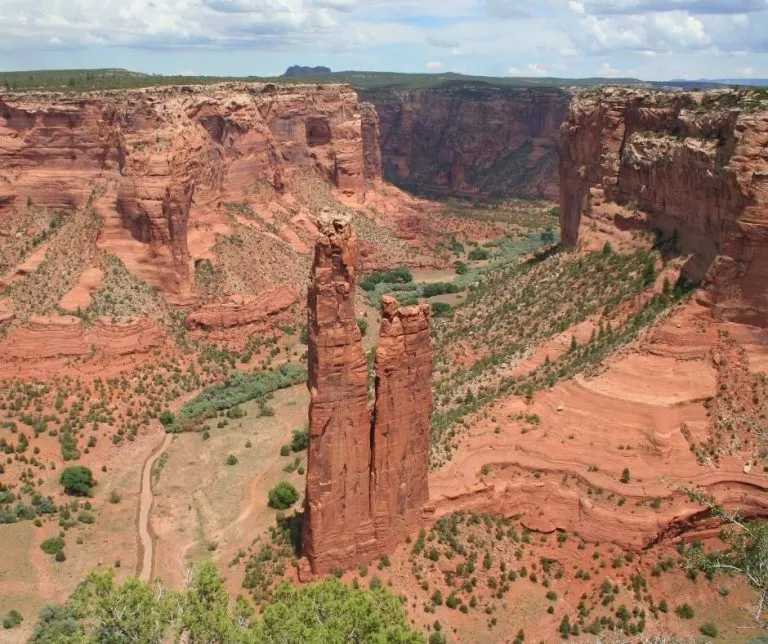
Distance from Phoenix: 294 miles, (5 hours)
The walls of Canyon de Chelly protected the native people for nearly 5,000 years. Navajo people still raise livestock and farm here. Today, visitors can view the remains of ancient pueblo villages, such as White House Ruins, from overlooks on the two scenic drives around the canyon rims.
South Rim Drive is 36-miles round trip, paved and accessible all year. It has a few different scenic overlooks to stop at along the way. North Rim Drive is close to the same distance and has different overlooks, including Mummy Cave Overlook which has a cliff dwelling. The light on this route is best in the afternoon. Vice versa for South Rim Drive.
This park is located on Navajo tribal land and the United States shares it with the Navajo Nation. To go inside the canyon, you must take a tour with a Navajo guide (fee required). Choose from a horseback ride, hike or guided off road tour.
The only trail you can hike inside the park without a guide is the White House Trail. It involves steep switchbacks as it makes the 2.5-mile round trip down to the canyon floor and ends at White House Ruin, a cliff dwelling. This hike is seasonal so check the park website before visiting.
Spend the night: Camping is available at the Cottonwood Campground on a first-come, first-served basis.
El Morro National Monument
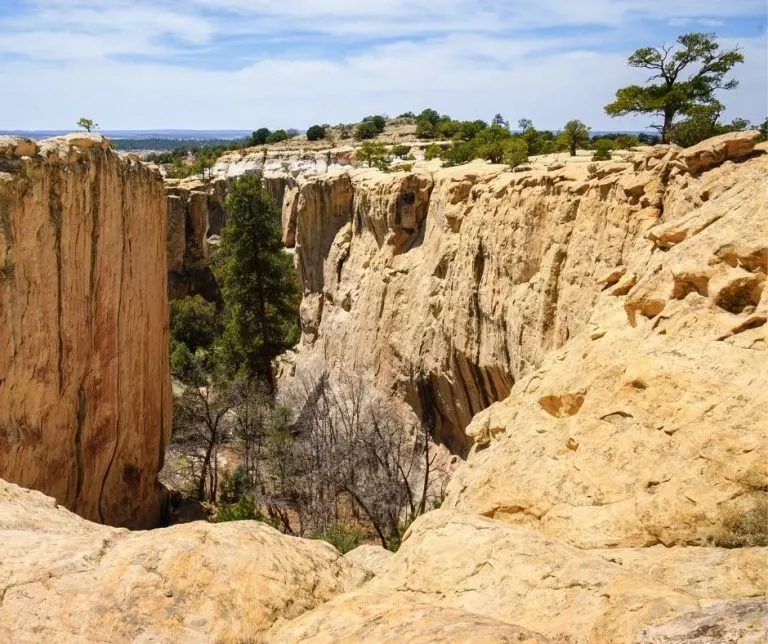
Distance from Phoenix: 314 miles (5 hours, 10 minutes)
Located in western New Mexico, El Morro National Monument is a park that protects ancient Puebloan petroglyphs, inscriptions by Spanish conquistadors, and messages by soldier and emigrants that have been carved into El Morro- a sandstone bluff that rises 200 feet above the valley floor.
The walk on the Inscription Trail, an easy half mile loop, is the park’s main highlight. Here you can see over 2,000 inscriptions and petroglyphs. There are some interpretive signs that will help you better identify what you are looking at.
If you are looking for a longer hike, the two-mile Headland Trail extends from the Inscription Trail and has nice views of the El Malpais lava flows and Zuni Mountain. You will also pass by the ruins of Atsinna Pueblo, a 355-room village inhabited from 1275–1350 AD.
Trekaroo tip: The park is closed during the winter and early spring on Tuesdays and Wednesdays. Check the park website before visiting.
Spend the night: Grants is the closest city to the monument (1 hour away) and it does have some motels like the Holiday Inn Express. If you are looking for a more unique experience, stay at the Inn at Halona Bed & Breakfast which is located on the Zuni Indian Reservation. There is a small campground inside the park with 9 first-come, first-served campsites.
Tule Springs Fossil Beds National Monument
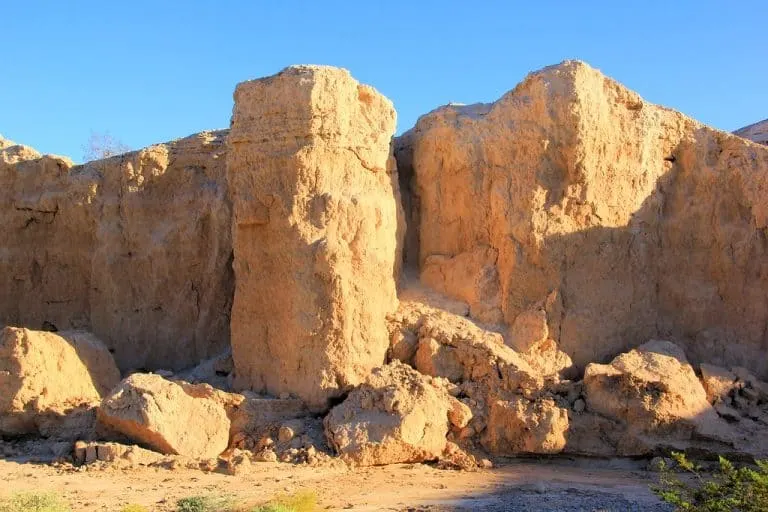
Distance from Phoenix: 318 miles, (5 hours 15 minutes)
Tule Springs Fossil Beds National Monument, within the Las Vegas City limits, preserves thousands of Pleistocene (Ice Age) fossils that were preserved by wetlands that were expanding and contracting in this location thousands of years ago.
Much of this monument is located in the Upper Las Vegas Wash, a rather dry and unremarkable looking locale most of the year. But what is remarkable is the number of fossils that have been found here- mammoths, bison, lions, horses, camels and sloths, all of whom lived in a wooded, riparian environment.
The best way to enjoy this monument is to sign up for a ranger-led hike which is typically 1.5 – 3 miles in length and a fun way to learn about the natural history of the park. They even offer dog-friendly Ranger-led hikes on select days!
Spend the night: Vegas baby! Need I say more?
El Malpais National Monument
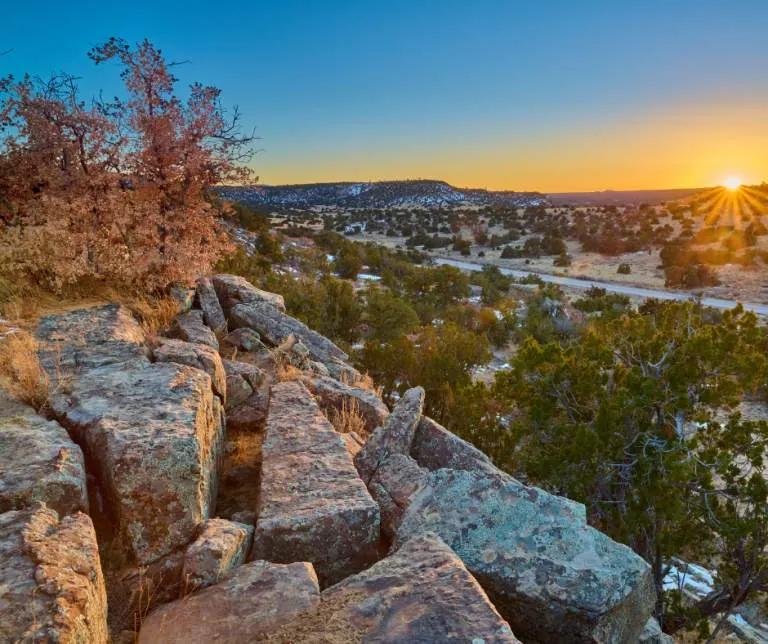
Distance from Phoenix: 321 miles (5 hours, 20 minutes)
Another national monument in western New Mexico is El Mapais which is known for its volcanic landscape. There are lava flows, cinder cones, lava tubes, and even ice caves.
Begin with a stop at the Sandstone Bluffs Overlook which has vast views of the acient lava field. You cann also stop at La Ventana Arch, which is located nearby, and is an easy walk from Highway 117.
Grab a free caving permit and explore the park’s lava tubes. Be sure to bring helmets and flashlights. Keep in mind that all lava tube caves are closed November 1 through April 30 each year to protect hibernating bats. Caving is best experienced by kids 10 and up.
There are some cool hikes to enjoy in this park as well. El Calderon Trail is a 3.5-mile loop past lava flows, sinkholes, cinder cones, and a collapsed lava tube. The Ice Cave is privately owned and easy to access with a small fee. Temps inside the cave never rise above 31 degrees.
Spend the night: There is no camping inside this park. Refer to the section on El Morro National Monument for lodging and camping suggestions.
Pipe Spring National Monument
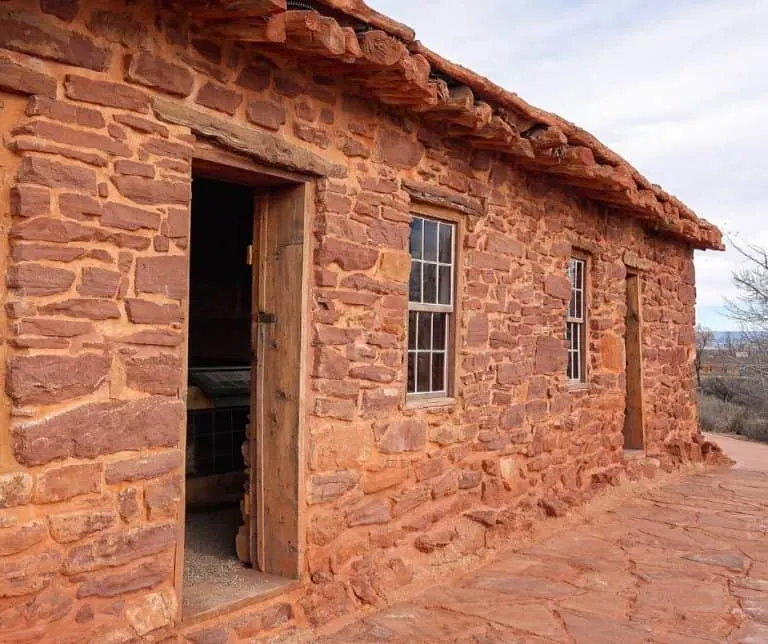
Distance from Phoenix: 352 miles (5 hours, 30 minutes)
Located in the high desert of the Arizona Strip on the Kaibab Paiute Indian Reservation near the Utah border, Pipe Spring National Monument is the site of Winsor Castle, a 19th-century stone fort built by Mormon pioneers as a tithing ranch.
The region has a long history of human habitation, thanks to Pipe Spring which is a sacred site to the native people who have lived in this area for centuries. There is a museum at the visitor center which tells the story of the site, including how Mormon settlement impacted the traditional way of life.
Pipe Spring is still a working ranch and there are several animals on property including chickens and longhorn cattle. During special events, live demonstrations of frontier life take place. Kids will love seeing how butter was churned and watching the blacksmith in action.
Spend the night: Kanab is a good home base for exploring this park and the others located along the Arizona Strip. It is about 15 miles from the park.
Zion National Park
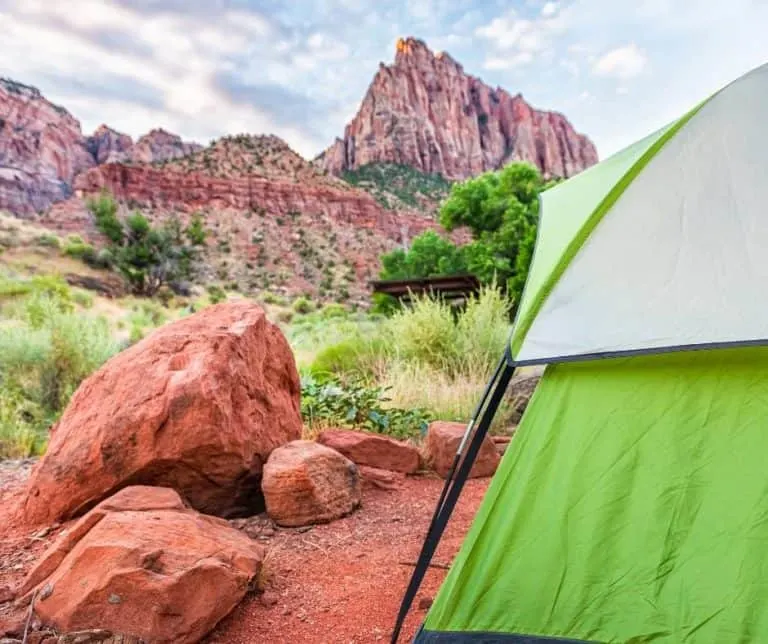
Distance from Phoenix: 380 miles (5 hours, 30 minutes)
Located in the heart of southern Utah’s red rock country, Zion National Park is an incredible all-season national park filled with tremendous scenery and multiple adventures.
The park utilizes a free shuttle service for most of the year which takes visitors to various stops inside of Zion Canyon where there are various trailheads and points of interest.
We have visited this park many times and have a complete guide to Zion National Park that I highly recommend you read before you visit. It covers all the best trails for families, tips for forging an adventure inside The Narrows, and lots of lodging and dining tips as well.
Spend the night: Zion Lodge is the only lodging within the park boundaries. There are hotel rooms as well as cabins. There are several really nice places to stay within walking (or a quick, free shuttle ride) distance of the visitor center in Springdale. We especially love the Cliffrose Springdale and Cable Mountain Lodge.
The most popular campground in Zion National Park is the Watchman Campground. The campground has tent and RV sites, clean bathrooms, and flush toilets. Recently, my family stayed at the Zion Canyon Campground and loved the location, hot showers, heated pool, and laundry facilities.
Find More Family Fun in Arizona
- Over 30 of the Best Things to do in Arizona with Kids
- The Top Things to do in Phoenix with Kids
- Fun and Free Things to do in Phoenix
- Things to do in Phoenix with Teens
- Fantastic Phoenix Family Resorts
- Amazing Outdoor Activities in Phoenix
- 30 National Parks Near Phoenix
- Awesome Weekend Getaways from Phoenix
- Phoenix Christmas Events
- The Best Parks in Phoenix for Families
- The 10 Best National Parks in Arizona
- The Best State Parks in Arizona
- The Best Things to do in Tucson with Kids
- The 10 Best Resorts in Tucson for Families
- Tucson Christmas Events
- Awesome Resorts with Water Parks in Arizona
- An Epic 10-Day Arizona Road Trip
- 18 Mountain Towns in Arizona to Visit
- The Best Places to see Fall Color in Arizona
- The Best Things to do in Scottsdale with Kids
- 17 Day Trips from Scottsdale
- Fun Things to do with Family in Flagstaff
- The Best Things to do with Kids in Mesa
- Great Things to do in Tempe with Kids
- Things to do in Yuma with Kids
- 10 of the Best Ghost Towns to Visit in Arizona
- 83 Best Disneyland Tips & Tricks for 2025 - June 20, 2025
- The 15 Best Island Vacations for Families in 2025 - June 10, 2025
- 10 of the BEST Waterfalls in the US- Easy Hikes and Big Views - June 9, 2025

